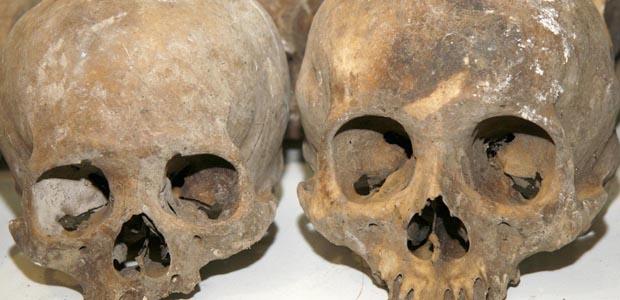Excavation of Human Skeletal Remains Botched in Mexico Cave
More than 100 skeletal remains were recently found in a cave in Southern Mexico. (Photo: (Photo: PGJE Chiapas /state attorney general’s office)
Earlier this month, the skeletal remains of more than 167 people were discovered in a cave in Chiapas, Mexico. Initial reports suggested the find may have been a mass grave. It wouldn’t have been the first such discovery in Mexico in the past year. Mass graves have become an increasing common discovery within the context of the country’s drug war.
But the human skeletal remains found in that cave in Frontera Comalapa, Chiapas turned out to be unique. It wasn’t a mass grave, but a pre-Columbian bone deposit.
“This is like the first time that’s happened, at least in my administration here in the state,” said Dr. Emiliano Gallaga, director of the Chiapas office of Mexico’s National Institute of Anthropology and History, known as INAH. The institute is the official caretaker of Mexico’s physical ancient history, like the remains in that cave. INAH should have been contacted before the bones were taken from the site, but that didn’t happen.
“My guess is that the person who discovered the cave with a bunch of skeletons got scared and called the police,” said Gallaga. “They saw there were a bunch of bones and they freaked out, because (of the) narco violence that we have… So they came right away, they collect the stuff, and they took it. And finally someone said, ‘wait a minute, this looks old!'”
Gallaga said it wasn’t until after the remains were removed that INAH staff were consulted. Because this find occurred over a weekend, they were only sent photos. Given that some of the skulls showed evidence of intentional cranial deformation, a practice used in ancient Mesoamerican societies, anthropology officials told police medical examiners that the bones could possibly be pre-Columbian.
Authorities from the state attorney general’s office held a weekend press conference to announce that this was not a recent mass grave, and the story soon dropped off the news radar. That left some important details ignored and questions unasked. First, how could an archaeological site have been mistaken for a modern-era crime scene?
Forensic anthropologist William Haglund, who has led mass grave investigations for the United Nations and Physicians for Human Rights, said the authorities in Chiapas failed to adhere to standard protocol for crime scene investigations involving skeletal remains. He said guards should have been posted at the scene because crime scene investigations can take several days to carry out, months if the scene is determined to be an archaeological find.
According to local media at the scene, state police and soldiers took a mere 15 hours to empty the cave of its remains. Video and photos from the crime scene show that authorities raked up bones with a hoe and stuffed them into bags for transport.
After analyzing the visual documentation, Haglund was bothered by tell-tale signs of reckless handling of the remains. “There were busted crania, there were recent fractures of bones,” said Haglund. “They stuffed them all into large bags and I understand they did it very, very fast and just… wrecked it for history. And the disrespect for the remains was just horrible.”
Crime scenes and archaeological finds share an important characteristic; diligent documentation from the start is crucial to understanding how and why remains got there.
“Once you’ve changed the context, it’s gone, it’s destroyed. And that’s what they’ve done,” said archaeologist James Brady at Cal State in Los Angeles. “They’ve completely destroyed that site. They’ve raped it. To me, all of that bone that they’ve recovered is of negligible value without the context.”
Dr. Brady specializes in the study of caves in ancient Mesoamerica. He said that, while it’s common to find human skeletal material in caves, this particular discovery was huge. “This was a very important discovery,” said Brady. “We haven’t had a cave with this many burials in that area before. And so to have something of this magnitude utterly destroyed is just awful.”
According to the Chiapas state attorney general’s office, state police and soldiers participated in the removal of the remains from the cave. Even if the find in Chiapas had been a mass grave, it would not have been the first time authorities have radically departed from standard crime scene protocol. The largest of these modern-day grave sites have been found in and around the state capital of Durango. At least some of the 300 bodies which have been uncovered were damaged by the use of heavy machinery to extract delicate, decomposing remains.
“It sounds to me like they’re not really invested in solving anything,” said forensic anthropologist William Haglund.
If the past year is any indication, mass graves attributed to drug war violence will continue to pop up around Mexico. And questions regarding the fate of thousands of disappeared persons will persist. But if the methods used to collect evidence from that cave in Chiapas are indicative of those used nationwide, answers to those questions will remain elusive.
Every day, reporters and producers at The World are hard at work bringing you human-centered news from across the globe. But we can’t do it without you. We need your support to ensure we can continue this work for another year.
Make a gift today, and you’ll help us unlock a matching gift of $67,000!
